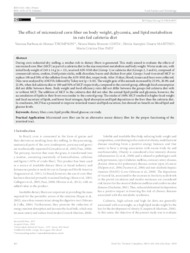The effect of micronized corn fiber on body weight, glycemia, and lipid metabolism in rats fed cafeteria diet.
The effect of micronized corn fiber on body weight, glycemia, and lipid metabolism in rats fed cafeteria diet.
Author(s): THOMPSON, V. B. de M.; COSTA, N. N. B.; MARTINO, H. S. D.; PAES, M. C. D.
Summary: During corn industrial dry milling, a residue rich in dietary fibers is generated. This study aimed to evaluate the effects of micronized corn fiber (MCF) as part of a cafeteria diet in the macronutrient metabolism and body weight. Wistar male rats, with initial body weight of 249 ± 14 g (n = 13), received AIN-93M diet (Group 1) or cafeteria diet (Groups 2, 3 and 4), composed of commercial ration, cookies, fried potato sticks, milk chocolate, bacon and chicken liver pâté. Groups 3 and 4 received MCF to replace 100 and 50% of the cellulose from the AIN-93M diet, respectively. After 35 days, blood, tissues and feces were collected. Data were analyzed by ANOVA followed by Tukey test (p < 0.10). The weight gain of the animals increased by 25.9%, 20.8% and 22.0%, when fed cafeteria diet or 100 and 50% of MCF respectively, compared to the control group, although food consumption did not differ between them. Body weight and food efficiency ratio did not differ between the groups fed cafeteria diet with or without MCF. The addition of MCF to the cafeteria diet did not alter the animal lipid profile and glycemia, however, the accumulation of lipids in their livers was similar to the control group. The intake of 100% MCF resulted in higher fecal weight and fecal excretion of lipids, and lower fecal nitrogen, lipid absorption and lipid deposition in the liver than the cafeteria diet. In conclusion, MCF has a potential to improve intestinal transit and lipid excretion, but showed no benefit on blood lipid and glucose levels.
Publication year: 2018
Types of publication: Journal article
Unit: Embrapa Maize & Sorghum
Keywords: Fibra, Fibra dietética, Glicose, Perfil lipídico
Observation
Some of Embrapa's publications are published as ePub files. To read them, use or download one of the following free software options to your computer or mobile device. Android: Google Play Books; IOS: iBooks; Windows and Linux: Calibre.
Access other publications
Access the Agricultural Research Database (BDPA) to consult Embrapa's full library collection and records.
Visit Embrapa Bookstore to purchase books and other publications sold by Embrapa.

